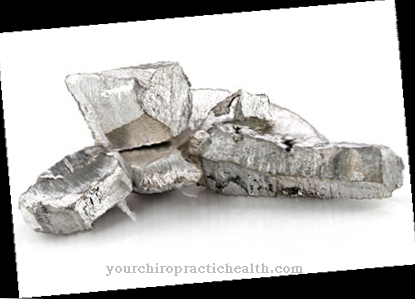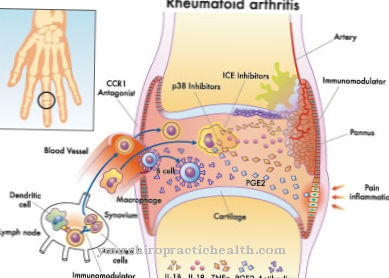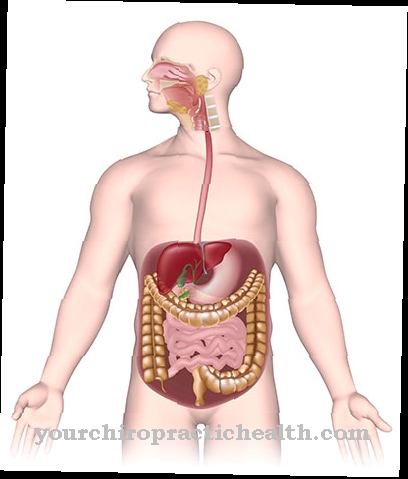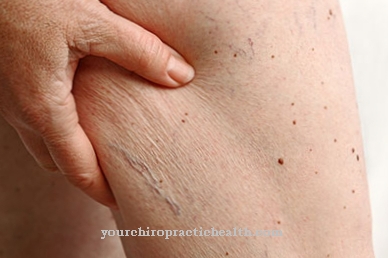hemophilia, which is popularly also known as hemophilia known is a hereditary disease that affects the functioning of blood clotting. In addition to preventive measures, long-term therapies are possible in severe cases.
What is hemophilia (blood disease)?
.jpg)
© Markus Bormann - stock.adobe.com
In the hemophilia or. hemophilia is a disease in which blood clotting is impaired. This means that blood that escapes from an injured person's wound either only coagulates very slowly or does not clot at all.
There are two varieties of hemophilia; haemophilia A and haemophilia B. Haemophilia B is the rarer of the two diseases; Approx. 85% of those affected have haemophilia A. Although hemophilia A and hemophilia B hardly differ in their symptoms, the coagulation factors involved are different in the two forms of hemophilia.
In hemophilia A, coagulation factor VIII is affected, in hemophilia B, factor XI is affected. In Germany, around one in 10,000 people is affected by haemophilia. Hemophilia is one of the most common hereditary diseases.
causes
The hemophilia is transmitted through the X sex chromosome. Because women have two X chromosomes, if they have a second healthy X chromosome they can transmit the hemophilia without being sick themselves; because hemophilia is inherited recessively.
This means that disease will only occur if there is no second X chromosome that is intact.
Since men only have a single X chromosome in addition to a Y chromosome, they will develop hemophilia if a non-intact X chromosome is transferred to them.
This is one of the reasons why women are less likely to suffer from haemophilia than men.
Symptoms, ailments & signs
The main symptom of hemophilia (hemophilia) is generally an increased tendency to bleed, which is usually already apparent in childhood. Bleeding is also greater during operations than in healthy people. Another sign is that when people are injured, bleeding may be difficult to stop.
Haemophilia in childhood can often be recognized by the increased tendency to bruise. Even small injuries can lead to severe bleeding in the tissue and joints, which can cause severe pain and, if insufficiently treated, can deform the affected joints. Cuts and abrasions are not a major problem because superficial wounds close just as quickly in hemophiliacs as in healthy people.
Bleeding around the head and internal organs is particularly at risk. A typical sign of the hemophilia may be bleeding that stops at first and then starts again after several hours or days. Mild haemophilia causes hardly any symptoms because spontaneous bleeding rarely occurs.
In the case of moderate hemophilia, severe bleeding can be caused by even minor injuries, and in the case of severe hemophilia, spontaneous bleeding can occur for no apparent reason, which bleeds into the joints and causes the typical joint pain (hemarthrosis).
Diagnosis & course
Symptoms of hemophilia are frequent bleeding in those affected. The bleeding tendency differs from patient to patient; above all, this has to do with how high the deficiency of coagulation factors is in the individual.
Most people who suffer from hemophilia have their first bleeding before they are one year old. The first signs of haemophilia can also be frequent and severe bruising. As a rule, abrasions or small cuts are no more dangerous for people with hemophilia than for healthy people, because the closure of such superficial injuries is intact in sick people (injuries to the head or the base of the tongue are dangerous, however). Hemophilia is usually constant. This means that in the course of life there is usually neither an improvement nor a deterioration.
Complications
With haemophilia, those affected suffer more from bleeding. These occur even with very small and simple injuries and can therefore significantly reduce the patient's quality of life. It is also not uncommon for bruises and blood clotting disorders to occur.
This disorder makes it difficult to stop bleeding, which in the event of an accident or major injury can lead to life-threatening emergencies. As a rule, the affected person is restricted in his everyday life by haemophilia and has to watch out for certain risks and avoid them. In most cases, the patient has suffered from haemophilia since birth and there is no spontaneous healing, improvement or worsening of the disease.
Unless there is particular bleeding or major injuries, life expectancy will not be reduced by this disease. As a rule, the treatment takes place with the help of medication. Those affected can also inject this themselves in order to be able to stop bleeding themselves if necessary. Since there is no causal treatment for hemophilia, lifelong therapy is required. Furthermore, there are no further complications.
When should you go to the doctor?
If bleeding occurs repeatedly that cannot be stopped with the use of plasters and other aids, the cause may be haemophilia. A doctor should be seen if the bleeding becomes more frequent and is associated with pain or bleeding disorders. If bruises are noticed at the same time, medical advice is required in any case. This is especially true for sudden bleeding and effusions that cannot be traced back to any specific cause. If bleeding already occurs with slight abrasions or small cuts, it is most likely haemophilia.
Because it is a genetic condition, no preventative measures can be taken. Parents who have hemophilia themselves should have their child examined early. If there are circulatory problems, palpitations and other complaints as a result of bleeding, the emergency services must be called. In the event of a circulatory collapse, first aid measures must be taken until medical help arrives. Children should be taken to the pediatrician if they have recurrent bleeding.
Doctors & therapists in your area
Treatment & Therapy
Currently is hemophilia not curable. The therapy of hemophilia depends, among other things, on the severity of the disease. If a person has severe haemophilia, therapy may consist of administering the necessary coagulation factors intravenously.
Corresponding coagulation factors that are administered in hemophilia can either be obtained from donor blood or produced by genetic engineering. If children have severe haemophilia, they are sometimes given coagulation factors at regular intervals. This can be done about two to three times a week.
If the hemophilia is less pronounced in a patient, an alternative to long-term therapy can be what is known as on-demand treatment. The administration of coagulation factors depends on the needs. Such a need would exist in the event of an acute bleeding or in the run-up to a necessary operation.
For example, the coagulation factors are administered to young children who are suffering from the hemophilia, usually first by a treating doctor. Affected parents can learn how to inject themselves so that they can then administer it independently at home.
You can find your medication here
➔ Drugs for wound treatment and injuriesprevention
Is a person of the hemophilia If affected, it can prevent the symptoms (bleeding) primarily through low-risk behavior. For example, leisure activities with a high risk of injury can be avoided. People suffering from haemophilia also usually have an emergency ID with them that provides information about the doctor treating them. Caution is also advised for sick people when taking various medications, as these can also inhibit the clotting of the blood.
Aftercare
For those who suffer from haemophilia, prevention, treatment and follow-up care go hand in hand. In any case, it makes sense to be careful with everyday activities to avoid bleeding. A sport with an increased risk of injury is therefore not recommended. However, less dangerous sports and travel are generally not a problem.
Those affected should always have their emergency ID with them. This contains all the important information in an emergency. In some cases, certain precautionary measures apply to the sick when taking certain medications that may have an effect on blood clotting. Whether the patient is an adult or a younger patient, relatives, friends and colleagues should be informed about the hemophilia to be on the safe side.
If there is an injury, those present know what to look out for. Where a plaster is sufficient for healthy people, the hemophiliacs need a firm pressure bandage. Those affected should keep their haemophilia ID up to date and always take it with them.
Medicines for better coagulation should also always be at hand. There is another possibility for parents of sick children: They can be instructed in the correct procedure for injecting the coagulation factors and administer the administration themselves.
You can do that yourself
Nowadays, despite having haemophilia, people affected by it can lead a largely normal life if some precautionary measures are followed. Family members, but also work colleagues, friends and teachers should be fully informed about the disease and about the possible consequences of major injuries. It is also important that the haemophilia ID is always up-to-date and ready to hand - medication prescribed by the doctor or any coagulation factors to be used if necessary should also always be on hand.
If minor bleeding is treated quickly with a pressure bandage, no further measures are necessary: In the case of injuries to the head or in the abdominal cavity, however, the person concerned should be carefully observed because of the risk of internal bleeding and a doctor should be consulted if necessary. Operations in the mouth area can cause major bleeding in haemophilia, so careful dental care and regular visits to the dentist should be extremely important to hemophiliacs.
Any medication may only be taken after consulting the attending physician or haemophilia center, as some active ingredients increase the tendency to bleed. Even hemophiliacs do not have to forego sporting activities: sports with a low risk of injury such as running, hiking, cycling or swimming are ideal; team sports with frequent body contact are less suitable.Vacation trips are also possible, and a sufficient amount of coagulation factor concentrates as well as sterile disposable syringes and needles should always be carried with you.



.jpg)




















.jpg)



